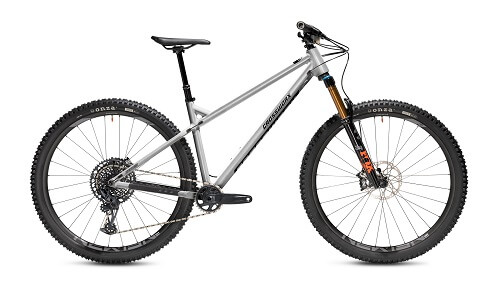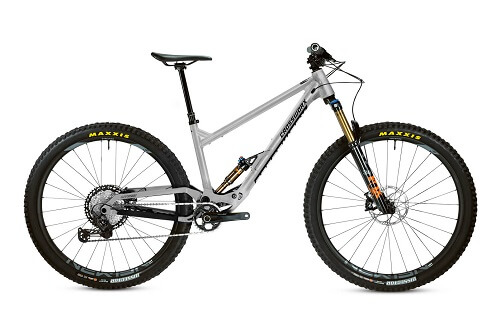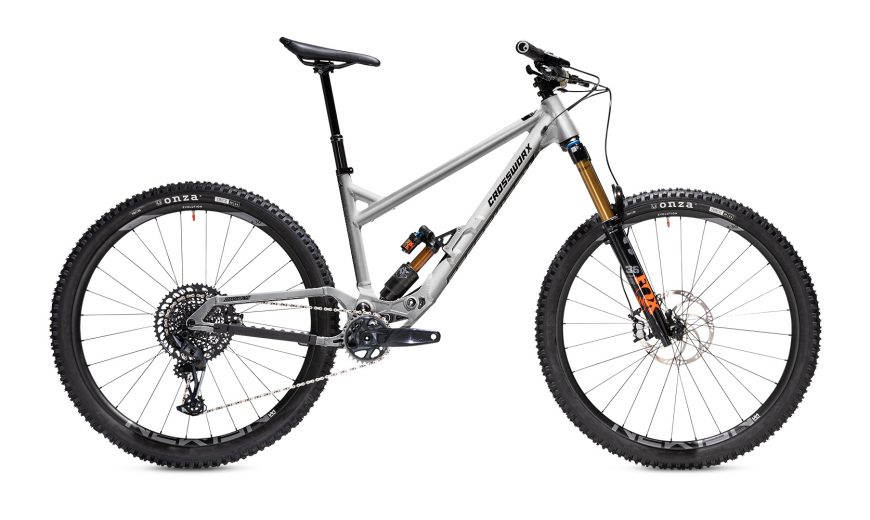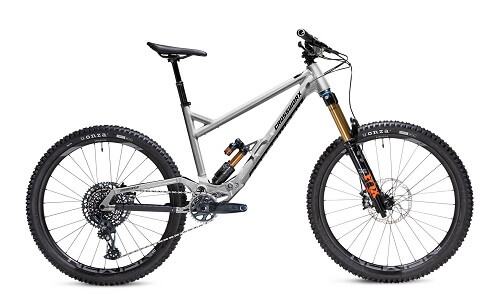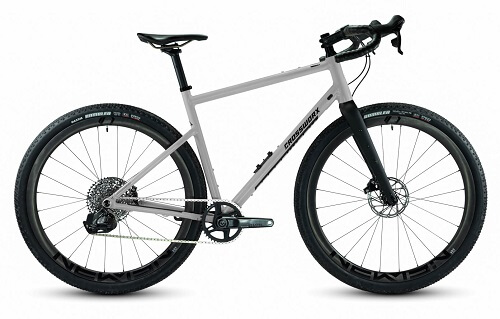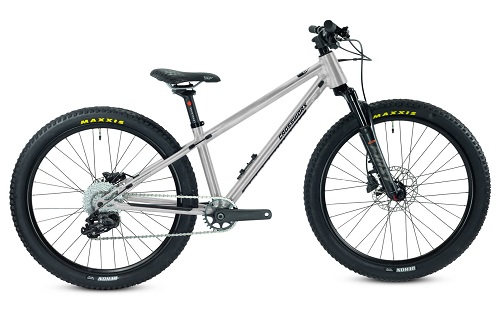An Idea become a Gravelbike
The starting point for this Gravelbike build was the desire for a Gravelbike suitable for rides ranging from 20 to 200 km. The challenge lay in the nature of the tours. It’s not entirely a mountain bike and it’s not purely gravel either. Eight out of ten ascents have gradients exceeding 15%, and the terrain isn’t always smooth road.
My requirements were to build a bike that is as robust as possible yet lightweight, capable of being fast when needed, able to carry bags on the frame and possibly on the luggage rack. It needed space for water bottles and, if possible, should be enjoyable to ride. And if it happens to be aesthetically pleasing… it’s a win-win!
Coming from the Crossworx ZERO290, the frame dimensions were a key consideration. My Zero preferred tours with occasional trails. The gravelbike would be more focused on long distances. In reality, I don’t ride a route under 40 km and 500 meters elevation gain. So far, the bike has covered 150 km and 2400 meters elevation gain at its peak.
All about the Look
It was visually clear from the start that the frame would remain raw. Primarily because it’s easy to maintain. Do the bags cause abrasion? Steel wool takes care of that. Is the frame scratched by small stones, etc.? Steel wool. Want a fresh look? Steel wool. In my mind it fits the Crossworx Ride280 perfect.
To complement this, in my opinion, high carbon rims must join a sleek gravel bike and the R38 wheels from Newmen were an obvious choice here. The Fade hubs roll smoothly, and the hub engagement aligns well with the desired mountain bike gearing. For me, a carbon rim also offers an unbeatable stiffness advantaged and I want to roll efficiently on a tour beyond 6 hours of riding. It’s okay if I can’t tackle every trail at full speed, but that wasn’t the goal of the bike either. There are simply other bikes with suspension for fun on trails
A crucial consideration was the drivetrain. It had to be 12-speed and preferably close to 500% gear range. Why? Firstly, the bike, in everyday use, doesn’t stay under 10 kg, especially when bags are attached, or when I decide to embark on an overnighter. Due to the weight uphill and the fairly steep ascents, I need the gearing to avoid constantly pushing 400 watts.
Watt is FTP?
That’s a good point. A power meter was also essential. Firstly, because the RIDE280 serves as a training tool, and training based on heart rate may not be as informative. Secondly, having a power meter allows me to consciously pace myself better.
What drives me?
Now the question naturally arose, what could be done in this situation? Since, at that time, a 12-speed drivetrain from Shimano wasn’t readily available for a gravel bike, at least not without significant effort, SRAM was the only option. So, a hybrid of a GX transmission with APEX shift-brake levers and a power meter in the crankset seemed like the plan. However, things took a different turn. Out of nowhere, I had the opportunity to get a new GRX 820 12-speed group from Shimano, which had just been introduced.
This worked out well for me because I preferred not to carry extra batteries for an AXS drivetrain. In my experience with MTB groups, the AXS rear derailleur sometimes unexpectedly stopped working. I’d rather stick with classic mechanical shifting, especially on a 200 km tour in the middle of nowhere.
The significantly more important factor, in my opinion, than the drivetrain is the contact points with the bike and their design—essentially bike fitting. I, at 1.82 m with an inseam of 86 cm, opted for the size L. Size Medium, in my understanding, would have been more of a ‘gravel bike,’ more compact. But that’s exactly what I didn’t want and I intentionally aimed for a geometry leaning more towards endurance. I preferred a slightly more laid-back position over the bike, not too upright. It was crucial that the frame felt very stable during pedaling and encouraged covering distances efficiently.
I wanted to complement this sportier approach with saddle height, aiming to achieve a more road-bike-like position. I was able to realize this setup.
If I sit, I sit!
The saddle choice was quickly settled. I’ve been riding SQ Lab for years without any issues. Although I generally tilt my saddle noses about 4 degrees downward, even this position suits me best on SQ LAB saddles. So, the 614 model in 140mm was chosen.
Following extensive research, this saddle was mounted on a Levelnine MTB carbon seatpost. Surprisingly, this post has some flex, which might bother some full-suspension riders but works just right on the gravel bike.
Contact points handlebar and handlebar tape also came from SQ LAB. MY choice was the all new 314 handlebar. At this handlebar the Fler approach sounds well thought out. Unfortunately, I didn’t get along well with the handlebar. It has already been replaced, and I’m currently riding on a ZIPP Course EXPL, which fits well but unfortunately has a too-small top surface area. My bar tape has been SQ LAB’s 712 from the beginning. It wraps nicely and is super comfortable.
Grab me by the horns!
Stack height was initially set low. I find this posture comfortable as I prefer to exert pressure. The stem is now even mounted without spacers on the steerer tube. Of course, the stem also has a negative inclination. The stack on the bike, at 620 mm in size L, is definitely on the comfortable side. Originally, I would have liked something around 590-595 mm. Based on my experience with road bikes and gravel bikes, I simply find a more athletic posture on unsuspended bikes more comfortable. Fortunately, you can hide this quite well with the mentioned measures. Let’s be honest, we’re not professionals, and it’s unlikely we’ll become them. 🙂
Considering my upper body-to-lower body ratio, I quickly realized that with a 70 mm stem, I would likely ride comfortably. It was a perfect fit. I’m sitting just right, with slightly bent arms on the hoods. Longer rides are no issue.
Fast AF Boy!
With the tires, I initially took the approach of rolling as efficiently as possible over gravel. I’ve been reading reports and experiences about tires for a while and, of course, have some personal experiences. On the mountain bike, I was very impressed with the Specialized tires and used them for a long time. Hence, I chose the Pathfinder for the RIDE280. It has a fast-rolling center tread and sufficient knobs on the edges for corners. Whether it can also perform well in winter remained to be seen.
Unfortunately, both tires were completely destroyed on a ride and couldn’t be saved with a tire plug and sealant. The choice of a 37 mm tire turned out to be less than ideal, as it was uncomfortable. Currently, I’m using Schwalbe G One R in 45 mm and am very satisfied with the choice.
I am happy!
All in all, I quickly reached my goal with the classic methods of bike fitting. Using the inseam length as a starting point for saddle height and a crank arm length of 172.5 mm worked well for the first ride, and I only had to adjust down by about 5 mm. With the now more suitable reach and drop at the handlebar, I have a sporty riding position without experiencing numb hands or a cramped neck.
The Crossworx RIDE280 is simply enjoyable for me, and I try to sit on it and roll around as often as possible. I don’t even go on the mountain bike anymore. The entire concept of the bike is very coherent and suitable for me. I don’t have to stress if I don’t want to and can just let it roll. But I can also push it into Zone 4 when I feel like it. 😉

